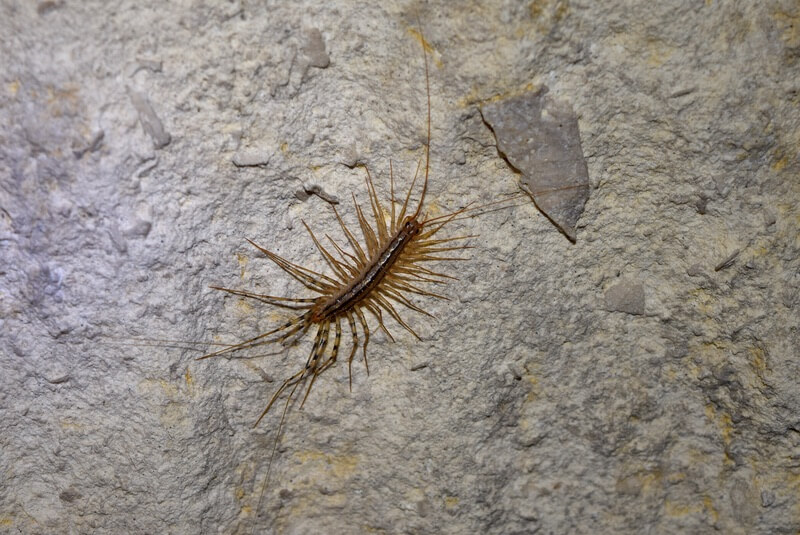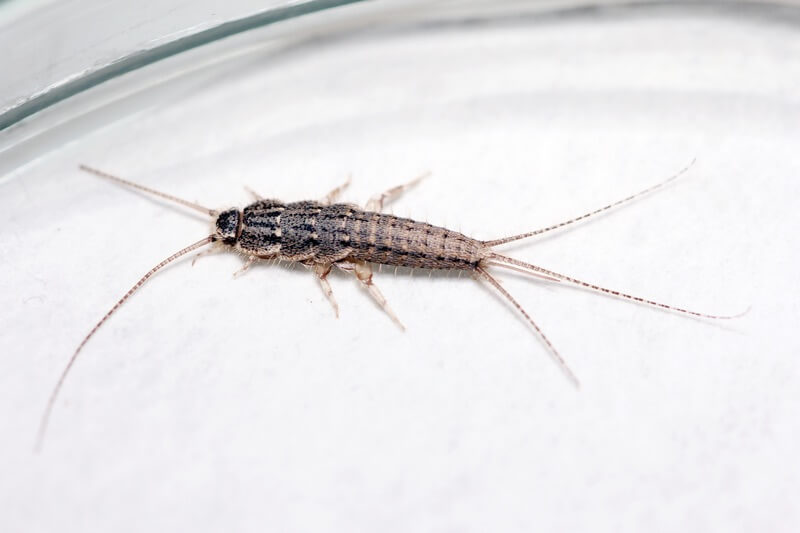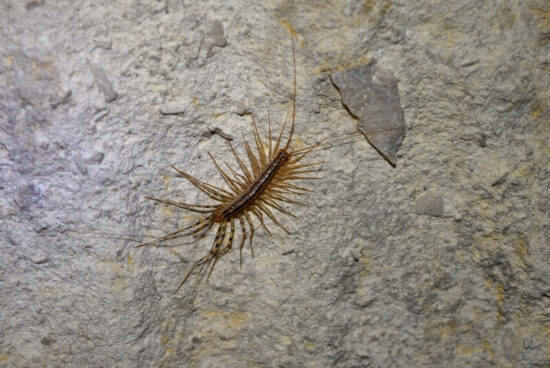The house centipede vs. silverfish comparison is something that many homeowners struggle with. When you see little bugs scurrying around, it can be hard to identify them!
This guide will go into the differences between silverfish and house centipedes, so you can deal with these pests appropriately.
Table of Contents
The Appearance Of House Centipedes
House centipedes are certainly one of the most terrifying-looking insects you can encounter in your home (despite the fact that they’re not dangerous). That’s especially true if you see a big one! Most house centipedes are around an inch or two long. However, they can grow up to six inches long in the right conditions.
Either way, the most defining feature of these pests is the legs. While their name would imply that they have 100 legs, they sport about 30 legs. The exact number will depend on how many body segments the bug has, but around 30 is the norm.

The house centipede’s legs are long and segmented. Thanks to the hinged joints, they look similar to a spider’s legs. Those agile legs can help these pests navigate most conditions while gliding around floors and furniture effortlessly.
If you manage to see a female house centipede, you might notice that it has longer legs in the back. They trail behind the bug, creating what many people mistake as a tail.
The color of a house centipede is yellow-ish brown. The bugs typically have dark bands running along the body. The dark-colored bars run vertically, helping to elongate the body. Those stripes often continue on the leg, forming a distinct striped pattern.
Observe closely, and you’ll see two delicate antennae. The antennae can look almost identical to those two trailing legs we mentioned earlier on females. However, the antennae are thinner and are actively used for navigation.
The Appearance Of Silverfish
Silverfish are a unique bug that can look just as intimidating as the house centipede. It has a distinct appearance. As its name would imply, people often compare its look to that of a tiny minnow fish!
The body is usually silver and reflective. The shine makes the bug relatively easy to spot in the right lighting conditions. Some might also take on a dark-brown hue. Either way, silverfish tend to be noticeably darker and more reflective than house centipedes.

The bug’s body is also smooth and segmented. House centipedes have multiple segments, too. However, the individual sections are usually more noticeable on a silverfish because they lack any distinct color pattern or banding.
In terms of size, silverfish are small. While house centipedes can grow up to six inches, silverfish are an inch or less when fully grown.
Now, let’s talk legs! This is one of the biggest differences between silverfish and house centipedes. Silverfish don’t have nearly as many legs as the centipede. They only have six. Not only that, but they’re much shorter and harder to see.
Silverfish legs are usually white or off-white, offering a stark contrast to the shiny gray body.
These bugs have two antennae on the head for sensing things in the environment. Once again, the silverfish’s antennae are smaller than the house centipede’s. But they’re functional nonetheless.
The most exciting part of the silverfish’s body is the three appendages on the ear. They can be longer than the front antennae, forming what almost looks like stingers. Thankfully, these appendages are nothing more than sensory tools.
Diet Differences
When it comes to the comparison of house centipedes vs. silverfish, their diet is an area where these insects differ quite a bit.
Both are pests you don’t want in your home, but silverfish tend to be the most destructive. That’s because they prefer to eat carb-heavy foods and sugars.
These insects have a healthy appetite, and they’ll get into anything they can. They’re notorious for invading pantries and consuming things like flour, sugar, and any fibrous food they can get their little mouths on. The bugs even eat boxes and paper products.
The reason why silverfish are so problematic is that they ruin delicate fibers. That includes paper and clothing!
Expert Tip: If you ever open up an old book and see small holes within the pages, it was likely a silverfish’s meal at some point. The same goes with old clothes stored near silverfish habitats. However, the good news is that they usually only eat natural fibers and choose to avoid synthetic materials.
Believe it or not, silverfish can also eat one another. The pests can cannibalize when other food sources are scarce.
So, what do house centipedes eat?
Typically, house centipedes go after a wide range of insects! They snack on termites, spiders, bed bugs, roaches, and even silverfish. While you might welcome centipedes for their bug-eating habits, seeing them around your home isn’t good.
If you start seeing house centipedes, there’s likely a decent population of other bugs around!
Behavioral Differences
Silverfish and house centipedes share a few behavioral habits. First, there’s their hatred for light. Both bugs are considered to be nocturnal. So, don’t expect to see them much in the daytime.
The insects usually spend their days hiding in the shadows. Silverfish are the smaller of the two, so they tend to gravitate towards cracks and voids. House centipedes can sometimes fit into discrete hiding places, too. However, one difference is that they often use items in their surroundings to find shelter.
Either way, noth bugs will essentially sleep when the sun is out. They emerge from those hiding spots when nightfall comes to search for food.
If you happen to come across a silverfish or house centipede, don’t expect to see much of it. Whether you turn on the lights or accidentally unearth its hiding spot, these two bugs are fast! They scurry to shelter faster than most people can catch them!
But what if you’re lucky enough to get your hands on them? This is where the house centipede vs. silverfish comparison gets more interesting. For silverfish, you don’t have to worry about anything. While we don’t recommend catching them with your bare hands, silverfish don’t bite.
House centipedes, on the other hand, can deliver a pretty nasty bite. It’s not the end of the world, and most bites don’t require medical attention. However, it’s still a painful experience.
These leggy insects do have some weak venom. Many compare house centipede bites to bee stings. You might experience inflammation and pain, but the problem isn’t life-threatening.
Fortunately, house centipedes usually don’t bite unless provoked. Keep plenty of distance and don’t agitate the bug; you shouldn’t have to worry about bites.
At night, silverfish and house centipedes will look for any available food they can find. They’ll also mate and lay eggs to further the population.
One difference worth noting is that house centipedes have a more modest mating ritual. They lay about 35 eggs during the spring and summer seasons. Males will deposit sperm randomly for females to find and use for fertilization.
Most centipedes will seek soil to lay eggs. As a result, it’s not a huge problem in homes.
But silverfish are the worst offenders. They lay up to 60 eggs every single day! To make matters worse, silverfish lay eggs everywhere. They don’t need soil or any special conditions.
If you have a silverfish infestation, there are likely many eggs around that are causing the population to grow.
Where You Can Find House Centipedes
House centipedes need moisture to stay alive. As a result, you’re most likely to find them in rooms that have easy access to a water source. That means your bathroom and kitchen are fair game!
These bugs are capable of crawling into faucets and pipes. However, they also like leaks. If you have a leak in your basement or other dark space, it’s the perfect living arrangement for a house centipede.
It’s important to remember that these bugs also need easy access to food. But because their primary food source is other bugs, they don’t have to look very far.
Other insects need water for prolonged survival, too. As a result, those rooms with easy access to moisture, whether it’s from a faucet or a leak, often attract a wide range of pests.
You may also find house centipedes near openings. For example, you might see them hanging around mud rooms, near outdoor vents, and plumbing that goes to your home’s exterior. Again, it’s all about staying near food and water sources.
Those entry points are how other bugs get in, so the centipedes will stick around for an easy meal.
Where You Can Find Silverfish
Silverfish also need water to stay alive in your house. They, too, often gravitate towards kitchens and baths. Both house centipedes and silverfish are known to live behind toilets, in dark sink cabinets, and in other similar areas.
Kitchens tend to be a popular spot for silverfish. The reason for that might be the proximity to the pantry. These bugs enjoy high-carb foods, flour, sugar, and fibrous paper.
You might see them in places where you store boxes, too. Silverfish are notorious for getting into attics, destroying old photos and documents, and laying eggs all over boxes.
Don’t forget to look in your basement, too. Any place that’s dark and relatively unused is perfect for silverfish. They can eat all the food they need, lay eggs to increase the pest population, and stay out of sight!
Conclusion
Now that the house centipedes vs. silverfish comparison is clear, it’s time for you to start getting rid of whichever kind is in your home. Understanding the differences will help you identify them and come up with an effective course of action.
If you’re still having trouble telling them apart, let us know! We’re more than happy to help.


